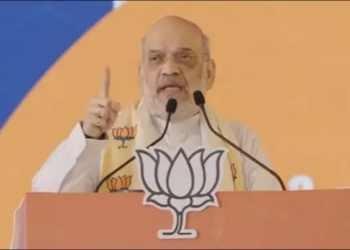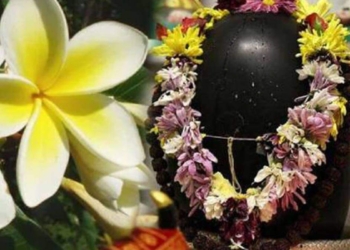Look at the state symbol of the Government of Karnataka, what is seen? If you look carefully, you will find that there is a red shield in the middle of this symbol. This shield is a symbol of security. A white bird -like shape appears on this shield. Note that this bird has two heads and the way it has been engraved in the middle of the shield is its symbol, both the shield and the bird are the same as the protector. The border of the shield is blue, on which the Ashoka Chakra is inscribed, which is the national symbol of India.
State symbol of Karnataka government
Two red and yellow gajakesis (half lions and half elephants) are depicted on either side of the blue shield with a blue shield. It is a symbol of mythological animal intelligence, strength and prosperity, which is a combination of lions (valor) and elephant (intellect). This symbol represents the rich cultural and historical heritage of Karnataka as well as the power, religion and administrative stability of the state. Advertisement This symbol of the government symbol of the Government of Karnataka is inspired by the military symbol of the Mysore Empire. This symbol has its own history in the Mysore Empire.
Now look at the symbol of the University of Mysore (Mysore University). In this too, you will see the same bird figure with two heads in the middle. The motto of the university is inscribed “Nahi Gyanean Samashiram” (in Sanskrit, which means “nothing similar to knowledge”). This reflects the university’s commitment to education and knowledge. The symbol usually uses blue, red and golden colors, which represent royal and academic dignity. A two -headed bird is also engraved on a shield here. This similarity in the symbols of the Government of Karnataka and the University of Mysore shows that the roots and relations of the two belong to the Mysore Empire.
Is this bird just an example of rhetorical beauty?
The question arises whether a two -headed bird is just a rough example of the beauty of art, is it only for decoration, or is it just a painter’s imagination? No, you will be surprised that this two -headed bird is a mystery saga in itself. It is telling a huge mythological story with its presence, although some parts of this story have become blurred over time, but it is not a big deal for researchers to hide any story in it. Actually, this story and mystery begins with the name of this bird
What is the name of the bird?
Of course, you will not believe that this two -headed bird also has a name. That is, one thing is certain that these are not just fantasies. The name of this bird is Gandabhirund, also known as ‘Gandabhirund’. It is no longer found anywhere, but in the history of many centuries there is no evidence of seeing such a bird, which has two heads, but in many pages of India’s mythology, details of this bird are recorded, so it is considered a mythological bird.
What is the story of this bird?
The story of the presence of this bird in the Puranas is also very interesting. The story of Vishnu Purana mentions that Vishnu took a bizarre avatar to make Hiranyakashyap’s impossible death possible. He was neither human nor a link between the animals, but the two. As his mouth was like a lion, whose teeth were sharp, his face was surrounded by long hair (called Mane), but from the neck to the feet he was completely human. Standing on two legs, but the claws and nails of the hands are long and sharp like lions.
Story related to Narasimha avatar
One such idol of Narasimha can be seen in the Varaha Lakshmi Narasimha Temple situated on the Sinachalam hill in Visakhapatnam. According to the legend, Lord Vishnu killed Hiranyakashyap in this terrible avatar. Usually the story ends here, but no, stop now … This story is still more and its front is the center of ‘Gandabhirund’ bird.
When Narasimha’s anger did not calm down
It happened that even after killing Hiranyakashyap, Narasimha’s anger did not calm down and he started raging all around in uncontrolled anger. He wanted to destroy the earth and kill anyone who came in front of him. That is, Narasimha, who himself came to end an evil, had become a problem himself. Shivaji took steps to solve this problem. This story is described in the Vishnu Dharma Purana.
Shiva had an avatar to subdue Narasimha
Shivaji sent Virbhadra first, but Narasimha defeated Virbhadra with only one box. Now Shiva had to come himself, but he could not face Narasimha in his common Shiva form. Therefore, Shiva also took a terrible incarnation. Such an animal, which had 8 legs, four hands, a horse’s body, had wings and a lion -like face. In the Puranas, it has been described as the best incarnation of Shiva.
Sharabh jumped and Narasimha became Lord Vishnu’s chest. Then he grabbed both of his hands with one hand, grabbed the torso with four legs and pressed Narasimha’s feet with four last legs. Now Sharabh flew into the sky with Narasimha. Narasimha wanted to strangle Sharabh in anger, then Sharabh scratched Narasimha with his nails and scratched Singh’s skull with his torso. This destroyed the form of Narasimha and then Mahavishnu appeared in his quiet form.
Sharabh avatar Shiva lost himself in controlling Narasimha
Sharabh avatar also arises from sattvikta is a symbol of controlling negative anger. A part of the story ends here, but the story is still there. It further happened that Sharabh lost himself in an attempt to control Narasimha and now he became a new problem for the world. When no one could stop Shiva in the form of Sharabh, Lord Vishnu took a double incarnation of his vehicle Garun. Garun is a fast flying bird and is a symbol of knowledge and devotion. This is Gandabhirund.
This powerful bird had huge wings, strong claws and two mouths, bearing a sharp beak ahead. Now Gandabhirund took Sharabh in his possession and made him know the truth with his beak. Sharabh became Shiva who remembered everything and gradually he calmed down. In many idols, Gandabhirund is shown to defeat Sharabh and cut it like Hiranyakashyap, but in most of the idols, Gandabhirund is shown to Sharabh holding Sharabh in his claws and Sharabh is shown in a lord posture with two hands.
Gandy in idol and craftsmanship
The image of Gandabhirund in South Indian sculpture and art can be widely seen. This bird has been a part of royal and religious art due to its specific two -headed figure. The coins, seals and architecture of the Vijayanagara Empire (1336–1646) reflect the presence of Gandabhirund. For example, its carving can be seen in some ruins of Hampi. The golden and colorful pictures of Gandabhirund are carved on the walls and decorations of the Mysore Palace, which is also a symbol of the power and splendor of the Vodeyar dynasty. The Gandabhirund formation is also seen in the traditional handicrafts of Karnataka, such as kasuti embroidery and sandalwood carvings.
Introduction to frequency plotting
The frequency charting of painting has also started from the existence of Gandabhirund. Actually frequency plotting is a style of double pattern painting. In which the bellbutes are carved on half of the canvas. At the other end of the canvas, the same pattern of bell boots has been repeated. Both the pane of its front appears to be at the same distance from each other and their structure is also the same.
Carving on the walls of temples
Temples in Karnataka include Karnatki Gandabhirund carvings as religious and royal symbols. The excellent carving of this bird can be seen in Vidyashankar Temple (14th century) of Sringeri and Chennakeshav Temple (12th century) in Belur. These carvings were often performed at the gopuram or main gate of temples, which was a symbol of divine power and safety.
Lepakshi Temple (16th century, Andhra Pradesh, Vijayanagar region) shows the excellence of painting and carving Vaishnava art. In some Jain temples of Karnataka, such as Shravanabelagola, this symbol is also used as a symbol of power and knowledge. These carvings not only have religious significance, but also highlight the prosperity of the architecture of Karnataka.
Gandhirund’s carvings are also in Rameswaram temple
The Gandabhirund carvings can also be seen on the roof of the main building of the Rameswaram temple, one of the 12 Jyotirlingas. At the same time, the image of Gandabhirund can be seen in an old painting carved on the wall in the Brihadishwar temple of Thanjavur. Both temples and paintings are ancient, but its color is something new, which makes this carved painting more vibrant. Gandbhirund in Rameswaram temple, roof carving, Gandbhirund literature
Gandabhirund is also mentioned in Indian literature and texts. Apart from Vishnu Dharma Purana, its presence can also be seen in Kannada literature. Medieval poets such as Kannada Kavi Pampa and Ranna used the symbolically use of Gandabhirund or Gandabhirund in their actions, describing royal pride and power. In the historical documents of the Mysore dynasty, Gandabhirund is depicted as a royal symbol. In modern times, this bird is alive in the literature and folklore of Karnataka as a symbol of courage and victory. Additionally, the mention of a two -headed bird in Panchatantra and Jataka stories is associated with Gandabhirund (Gandhuddhudh), which represents moral and philosophical teachings.
Symbol of protecting religion and destruction of iniquity
However, this two -headed bird is a symbol of duality and unity, which reflects the balance of intelligence and power. It is considered a symbol of divine power, security and invincibility. Due to the influence of the Vaishnava devotional tradition in Karnataka, Gandabhirund was combined as a protector with Lord Vishnu, which was a symbol of protecting religion and destruction of unrighteousness. The use of Gandabhirund was also seen in the Vijayanagara Empire (1336–1646), a powerful empire in South India. This symbol is mentioned in some coins and inscriptions of Vijayanagar. The Mysore Empire, which emerged after the collapse of Vijayanagar, adopted this symbol and made it its identity.
A two -headed eagle bird was also found in the Russian Empire
Two -headed birds such as Gores are also found in other cultures, such as two -headed eagles or Byzantine symbols of the Russian Empire. However, the uniqueness of Gandbhirund lies in its Indian mythological and royal roots, which gives it a specific Karnataka identity. The story and mystery of Gandabhirund or Gandabhirund is not only rich, but their description attracts more than one mysterious bird or animal. In the ancient art of India, there are many such secrets of Sharabh statues, the details of Sharabh idols will be mentioned in the next issue.










